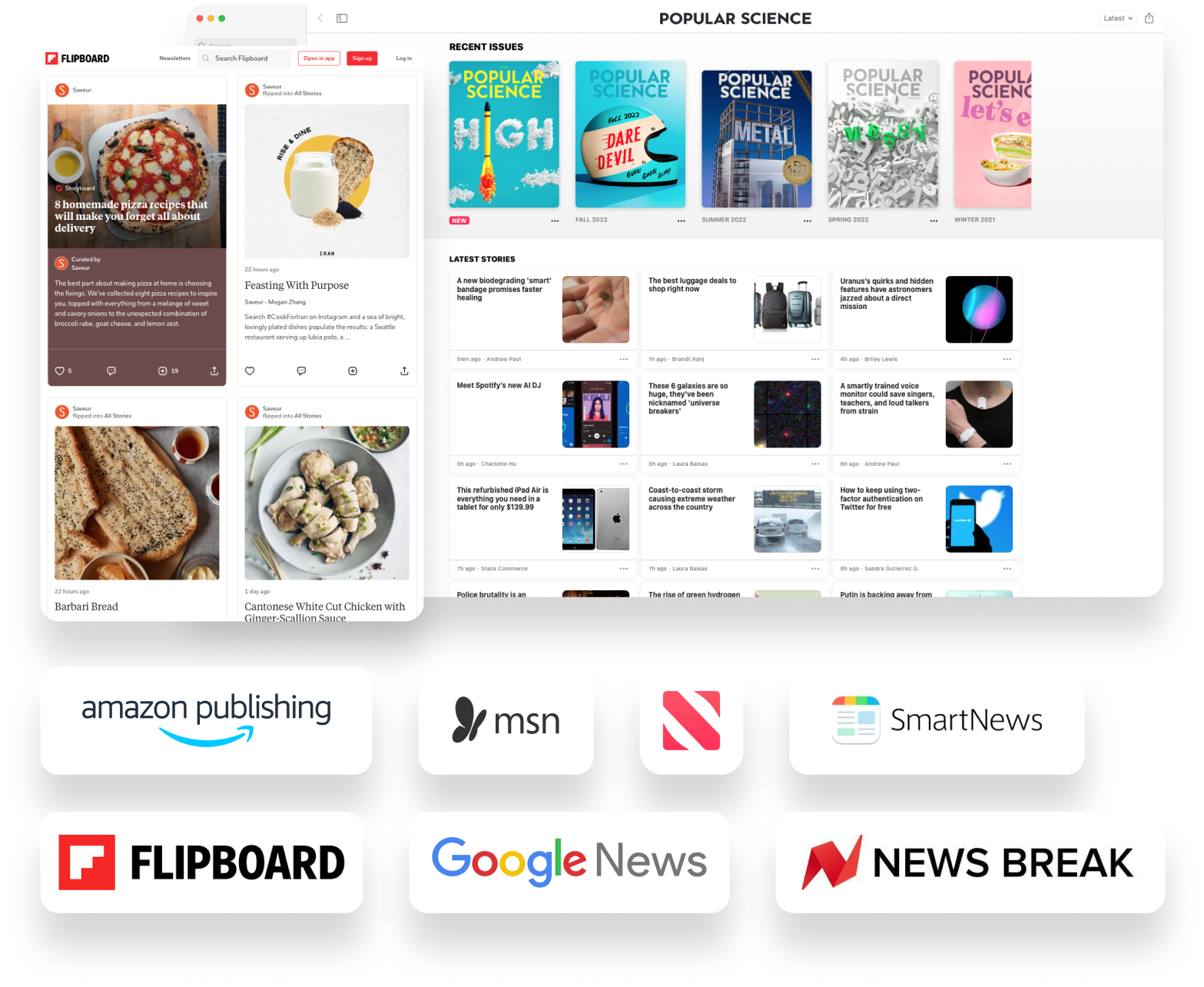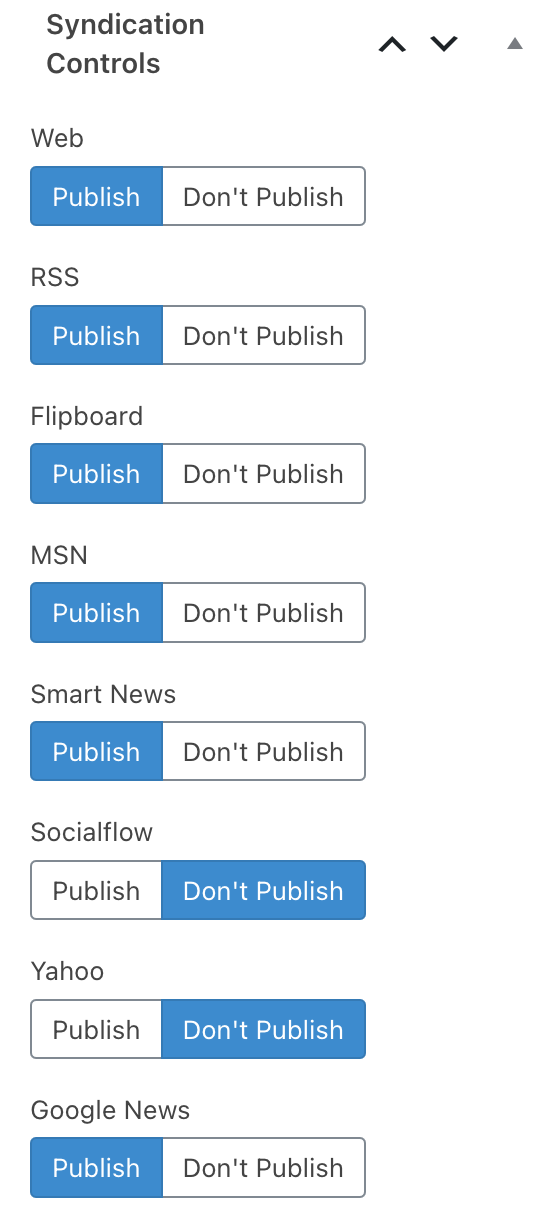Smart partnerships, great content, and the right techology stack ensure high-traffic website owners boost incoming referrals from content syndication partners such as Google Discover, Apple News, and MSN. Here’s our take on content syndication in 7 steps:

Smart publishers give time and attention to growing their traffic from organic search; savvier publishers make efforts to diversify their sources of traffic growth.
Yes, search traffic is vital for any healthy high-traffic site, but over-reliance on search spells trouble during every search engine algorithm update. Earning referrals from syndication partners represents another critical source of traffic, as well as incremental revenue—that too many website owners leave to chance.
Google Analytics (GA4) defines referral traffic as traffic originating from a link from another website, including syndication outlets and social media sites. Historically, both Google and digital strategists have conceived of referral and social as distinct traffic sources. Though they each represent important areas for growth, this article focuses on driving traffic through strategic publishing partnerships beyond social media.
To do conent syndication well, you need to actively position content for this channel. Syndication makes brands more resilient during algorithmic counter winds, not to mention drives incremental revenue and, yes, even generates more positive momentum for your search engine / SEO strategy.
Content Syndication provides incremental, off-site revenue in two ways:
- First, some syndication partners like MSN offer publishers a share of ad revenue on impressions served on their content.
- Second, publishers with affiliate marketing content can preserve revenue-generating links via syndication feeds, as in opening up a new readership you’re greatly expanding the opportunity to earn more revenue.
In allowing partners to republish content, brands reach new audiences who they might not have otherwise, but only when they’re smart about driving traffic back to owned domains via in-text links, “read more” cues, related content blocks, newsletter sign-up forms, and more.
Here’s how to get started with effective content syndicaiton, in 7 steps:
- Establish partner relationships
- Automate syndication streams
- Exclude unsuitable content from syndication
- Signal ownership
- Court on-site traffic
- Track success
- Expand
Content Syndication Step #1: Establish partner relationships
The first step to building reliable referral traffic via syndication is seeking out and building relationships with the various players in content syndication, including MSN, Yahoo, SmartNews, Google News, Newsbreak, Flipboard, and Apple News. You’ll need a bit of lead time to establish relationships and contracts with some desired syndication partners, so it’s wise to start the process of getting in front of these companies as soon as you can.
(j-FYI Here’s a more exhaustive list: NewsBreak; Google News; Inkl; CNN News; Yahoo News; Reuters; BBC News; Digg; Apple News; Flipboard; Feedly; SmartNews; Microsoft Start; NewsBytes; Fox News).
Syndication partners have requirements for working with content and/or commerce websites, including receiving content via RSS feeds, WordPress plugins, and/or API calls, so you’ll need engineering assistance.
Keep in mind syndication partners prohibit certain types of content, such as paid custom content, and also require brands remove this content from the RSS feed in order to keep the working relationship on good terms. Furthermore, content that syndication partners consider unsuitable, such as hunting content on an outdoor website or accident coverage on a car website, may be a normal part of the editorial cycle. So, again engineering assistance, but ensuring you configure the right content stream ensures your content gets seen by more and more subscribers, which increases revenue.
If you need help making sure to send the right articles to the right partners, please get in touch: hello@flexpress.ai.
Content Syndication Step #2: Automate syndication streams
 Headless CMS platforms have integrated built-in Syndication Control panels that makes it easy for high-traffic website owners to put syndication feeding on autopilot.
Headless CMS platforms have integrated built-in Syndication Control panels that makes it easy for high-traffic website owners to put syndication feeding on autopilot.
The key is making sure to customize settings at the individual post level. By generating unique feeds for major syndication partners such as MSN, Yahoo, Newsbreak, SmartNews, Flipboard, and Google News, content editors can personalize where each piece of content gets sent.
Once a new article publishes, content will automatically direct to the custom-selected syndication feeds. Platforms like Flexpress also integrate with the Apple News plugin to enable brands to send free and paid content to that outlet via API — “application programming interface.”
As an added benefit, website owner should take advantage of tags and category feeds. These are RSS feeds that include each piece of content from within a specific taxonomy item. Configuring these types of feeds is especially beneficial for automating distribution to partners like Flipboard and Pinterest.
Remember, provide not just one, but several feeds to populate distinct content streams to your desired partners. With the right content reaching the right audience automatically, you’re generating incremental revenue — all without draining away editorial and content teams’ precious time.
Content Syndication Step #3: Exclude unsuitable content from syndication
Another value-add when taking the syndication controls is in enabling your brands to exclude content from certain syndication outlets. Configuring global site settings allows brands to set automatic content exclusions by category, or tag, earning traffic from even some of the strictest syndication partners. Better, partners will never blow up your phone complaining about illicit content, and content editors waste less time.
While global default settings help automate syndication, there’s plenty of room for customization. At the post level, editors can toggle syndication partners off or on as needed to customize their feeds and ensure content reaches the intended partner’s audience.
Content Syndication Step #4: Signal ownership
When it comes to syndication, one concern that publishers and SEO experts often raise is the question of duplicate content.
Google has long discouraged sites from publishing duplicate content — but there’s no penalty for partnering with syndication outlets as long as you’ve engineered the connection correctly.
Another concern we’ve heard is that by sharing content with large distribution sites, brands may risk competing with syndication partners in search results pages. Goes back to the web engineering under the hood, but the right configuration ensures website owners can successfully syndicate content without any damage to their online reputation or domain rating.
This tag should link to the original source of that content, which is the article’s URL itself. After that, brands can ask syndication partners to also add a rel=canonical tag pointing to the original post. Most syndication partners will already do this, using the links provided in the custom RSS feeds.
An alternative approach favored by other brands when working with syndication partners is to ask them to tag a syndicated post as noindex to exclude it from Google search results. Because a post marked with a noindex tag discourages Google to crawl it, the article likely won’t compete with the original post for visibility in search results pages.

Content Syndication Step #5: Court on-site traffic
When syndicating content, the best way to drive traffic back to an owned domain is via hypertext links embedded within the post. These text links need to be contextual and relevant to the particular topic at hand, and they may take the form of an editorially curated list of related links added to the bottom of articles.
Whichever approach a brand uses when adding inbound links, it’s important that links offer relevant information to readers. Avoid the appearance of spamming readers with unnecessary visual noise at all costs. Once interested readers start organically (ahem) clicking through, i.e. driving interest naturally, brands can reap rewards in the form of incremental, monetizable on-site traffic.
Another way that some brands court on-site visits is by inviting syndication-site readers to engage via subscribing to email newsletters or following on social media channels. Often these appeals are made via text links.
Some syndication partners allow brands to take a more product-based approach. For instance, wen using SmartNews you can choose to take advantage of a module on that site that encourage users to sign up for email newsletters.
Syndication control settings allow brands to manage this process easily from the WordPress, or other editor backend.
Content Syndication Step #6: Track success
There are multiple ways to measure the success of a syndication partnership program. Because partners provide ad share revenue for off-site pageviews, revenue is the obvious metric to gauge success.
You can track revenue attributed to syndication from within Google Analytics, Flexpress Analytics, or other platform that breaks down earnings by syndication partner.
Something that’s a bit harder to quantify, because effects are often indirect, is to monitor changes to organic search traffic. Using SEO tools like Ahrefs, brands can track changes to the number of inbound links, which may grow due to syndication partnerships, which will of course positively impact search traffic.
Read more: How Flexpress improves SEO for publishers.
Also, don’t forget to keep an eye on changes to direct traffic. As brand visibility increases due to syndication opening up a new channel to reach new audiences off-site, brands will see direct traffic increase. New readers will continue to seek out publications that create content they love.
Content Syndication Step #7: Expand horizons
In order to boost referral traffic, look beyond your website and other owned channels. And remember, this growth process of getting the “audience you want” vs. the “audience you have” need not be a burden on editorial teams. That’s the beauty of syndication.
You’re growing referral traffic — without employing high touch content marketing strategies like courting backlinks, or sinking time into guest posts. Take the time to automate personalized content delivery to each syndication partner. The incremental revenue will be yours.

Interested in learning more about how Organic can help you grow your referral traffic? Send us an email.




